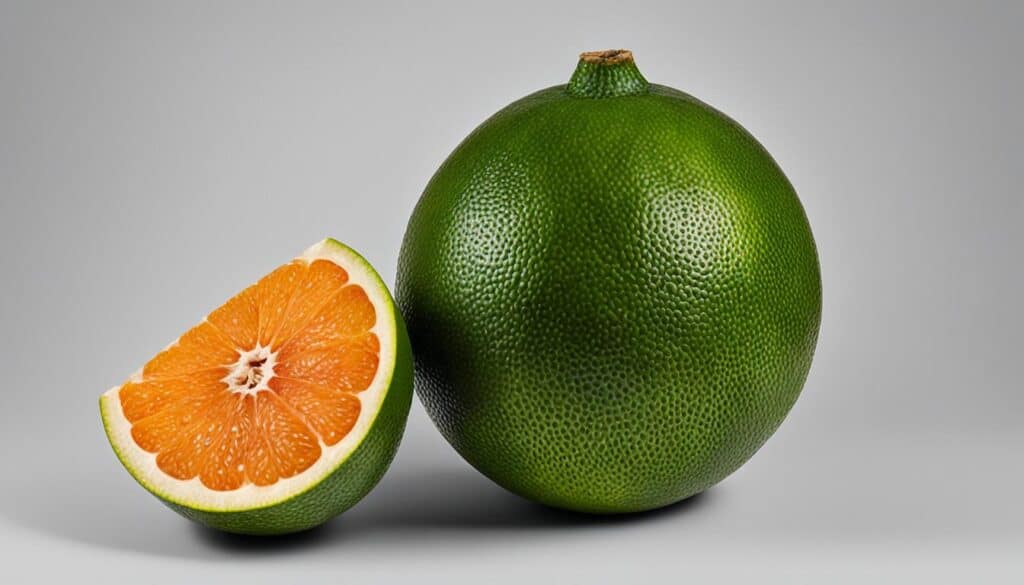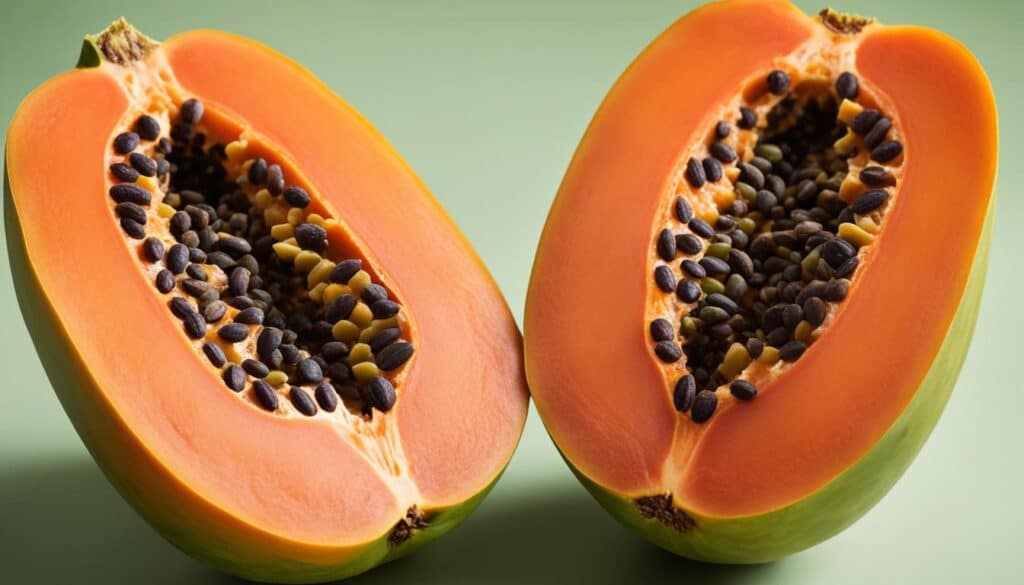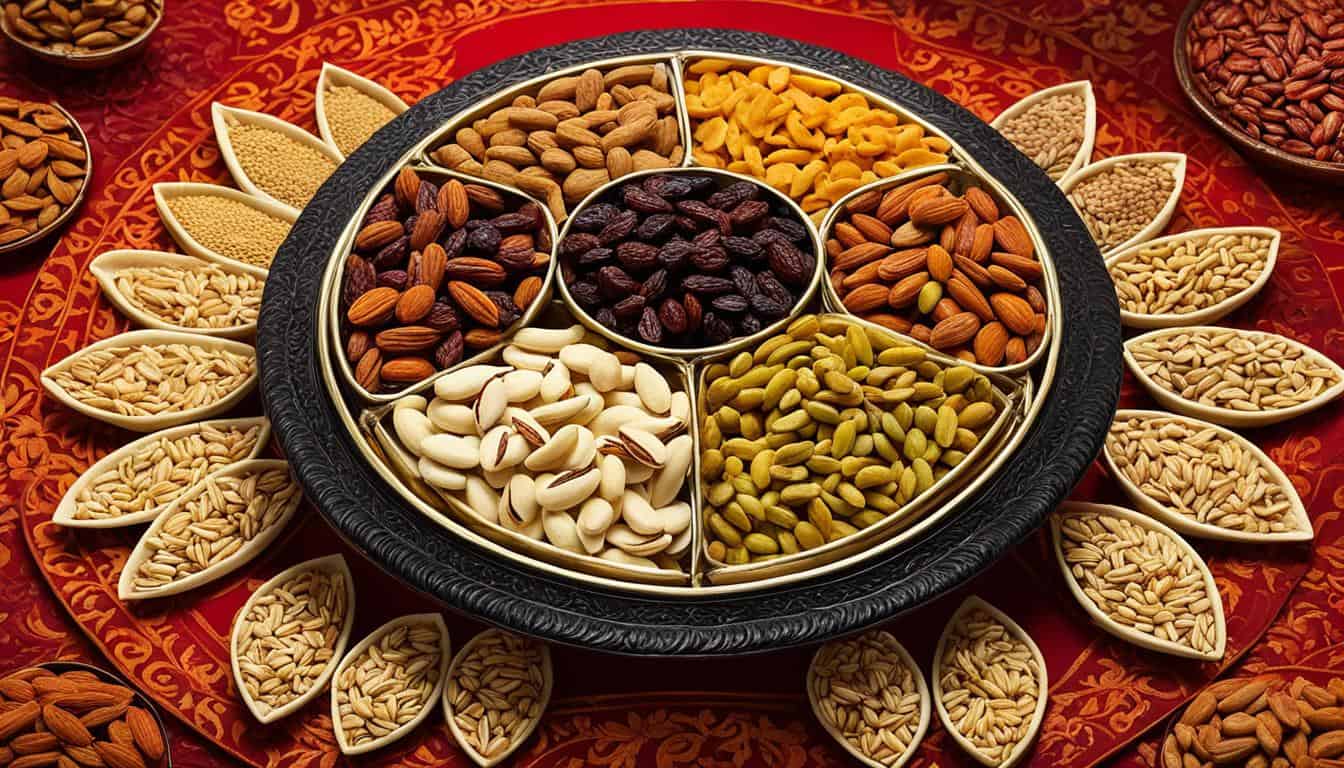In this comprehensive guide, I will provide you with a complete list of fruit names in Hindi and their English translations. Whether you’re looking to improve your bilingual skills or simply want to know the English names of Hindi fruits, this guide will help you master fruit names from Hindi to English.
Key Takeaways:
- Expand your fruit vocabulary by learning the Hindi and English names of fruits.
- Improve your bilingual skills and communication by recognizing fruit names in both languages.
- Enhance your cooking abilities and navigate recipes with ease.
- Make informed choices by understanding seasonal and indigenous fruit names.
- Store and select fresh fruits using expert tips and techniques.
Why Learn Fruit Names in Hindi and English?
Learning the names of fruits in both Hindi and English can be highly beneficial in various situations. Whether you’re shopping for fruits, reading recipe books, or discussing fruits with others, knowing fruit names in both languages allows for effective communication and understanding.
By understanding the meanings of Hindi fruit names in English and recognizing fruit names in English script, you can easily identify and comprehend the names of different fruits in both languages. This knowledge enables you to navigate fruit-related situations confidently and engage in discussions about fruits with ease.
For example, when you come across a Hindi fruit name in an English recipe book, you can readily understand which fruit is being referred to. Similarly, when shopping for fruits, you can express your preferences or requirements accurately by using the appropriate fruit names in the respective language.
Learning fruit names in Hindi and English is like unlocking a door to better communication and understanding in fruit-related contexts.
Whether you’re a language enthusiast, a food lover, or someone interested in expanding your knowledge of languages and cultures, grasping fruit names in Hindi and English opens up a world of possibilities and enriches your experience with fruits.
Next, let’s explore the importance of consuming seasonal and indigenous fruits, and how being aware of fruit names in both languages can aid in making informed choices.
Importance of Seasonal and Indigenous Fruits
When it comes to consuming fruits, opting for seasonal and indigenous varieties offers numerous benefits. Not only does it minimize our carbon footprint, but it also supports local farmers and ensures the freshest produce on our plates. By familiarizing ourselves with the names and recognizing the pictures of seasonal and indigenous fruits, we can make informed choices about the fruits we purchase and consume.
As we explore the world of fruits, it’s essential to understand the correct English pronunciation of Hindi fruit names. This knowledge not only enhances our ability to communicate effectively but also facilitates meaningful conversations about fruits in both languages. So, let’s dive in and discover some delightful seasonal and indigenous fruits along with their Hindi and English names!
“The bounty of seasonal and indigenous fruits not only delights the taste buds but also nourishes our bodies and supports sustainable practices.”
Benefits of Seasonal and Indigenous Fruits
1. Freshness: Seasonal fruits are harvested at peak ripeness, ensuring superior flavor and maximum nutritional value.
2. Economical: Since seasonal fruits are abundant during their respective seasons, they tend to be more affordable, allowing us to enjoy a wide variety without breaking the bank.
3. Reduced Environmental Impact: By consuming locally grown fruits, we reduce the carbon emissions associated with long-distance transportation and support sustainable agricultural practices.
4. Support for Local Farmers: Choosing seasonal and indigenous fruits encourages local farmers, helping them sustain their livelihoods and preserve traditional farming methods.
5. Diverse Nutritional Profile: Seasonal fruits offer a diverse range of vitamins, minerals, and antioxidants that contribute to our overall health and well-being.
Now that we understand the importance of consuming seasonal and indigenous fruits, let’s explore the Hindi and English names of some commonly available varieties:
Seasonal and Indigenous Fruits: Hindi to English Names
| Hindi Name | English Name |
|---|---|
| सेब (Seb) | Apple |
| केला (Kela) | Banana |
| संतरा (Santra) | Orange |
| आम (Aam) | Mango |
| अनार (Anar) | Pomegranate |
These are just a few examples of the delightful variety of seasonal and indigenous fruits available. Explore your local markets to discover more and enjoy the freshness and flavor they bring to your meals!
Tips for Buying and Storing Fruits
When it comes to buying fruits, there are a few key factors to consider in order to ensure you are selecting the best quality produce. By following these tips, you can enjoy fresh and delicious fruits:
- Look for bright colors: Choose fruits that have vibrant and rich hues. The color of the fruit can indicate its ripeness and flavor.
- Check for good aroma: Fruits should have a pleasant and fragrant smell. Avoid fruits with an overpowering or spoiled smell.
- Seek freshness: Examine the fruit for signs of freshness, such as firmness and smooth skin. Avoid fruits that are overly soft, mushy, or have wrinkled skin.
- Check for signs of ripeness: Different fruits have different indicators of ripeness. For example, a ripe pineapple should have a firm but slightly yielding texture and a sweet aroma.
- Avoid bruised or blemished fruits: Bruises and blemishes can be a sign of mishandling or poor quality. Choose fruits that are free from any damages or bruises.
Once you have purchased your fruits, it is important to store them properly to maintain their freshness and extend their shelf life. Here are some tips for storing fruits:
- Store fruits in a cool, dry place: Most fruits are best stored at room temperature or in the refrigerator. Ensure that the storage area is well-ventilated and away from direct sunlight.
- Prevent infestation and mold: Keep fruits away from areas with high humidity or moisture, as this can lead to mold growth. It is also advisable to store fruits separately to avoid cross-contamination.
- Consider organic options: If possible, opt for organic fruits to minimize exposure to pesticides and support sustainable farming practices. Alternatively, you can grow your own fruits at home for a fresh and chemical-free supply.
By following these tips for buying and storing fruits, you can enjoy the best quality produce and make the most of their nutritional benefits. Now let’s move on to the next section where we will explore the best practices for eating fruits.
Best Practices for Eating Fruits
When it comes to getting the most nutrition from fruits, it’s important to follow some best practices for optimal health benefits. By incorporating these habits into your daily routine, you can fully enjoy the natural goodness of fruits while ensuring their maximum nutritional value.
Eat Fruits as Nature Intended
One of the best practices for eating fruits is to consume them in their natural state, without any additional processing. By enjoying fruits fresh and unprocessed, you preserve their vitamins, minerals, and antioxidants, which can be lost through cooking or prolonged storage.
Peeling and Seed Removal
When eating fruits with inedible or hard peels, such as bananas or oranges, it’s important to peel them before consumption. Removing the peels ensures that you avoid any unwanted pesticides or contaminants and allows for better digestion. Additionally, for fruits with inedible seeds or stones, such as apples or cherries, make sure to remove them before eating to prevent any potential choking hazards.
Avoid Mixing Acidic and Sweet Fruits
While fruits are delicious on their own, mixing acidic fruits with sweet fruits in dishes like fruit salads or smoothies can sometimes lead to digestive discomfort. The combination of acids and sugars can cause fermentation in the stomach, resulting in bloating or indigestion. To avoid this, it’s best to consume acidic fruits separately from sweet fruits, allowing proper digestion of each.
Separate Fruits from Meals
To optimize digestion and nutrient absorption, it’s advisable to consume fruits separately from main meals. Eating fruits on an empty stomach or as a snack between meals ensures that they are digested more efficiently, as they require less time to break down compared to other foods. This practice allows your body to absorb the nutrients more effectively, promoting better overall health.
Remember to enjoy a variety of fruits as part of a balanced diet, as each fruit brings its unique combination of vitamins, minerals, and antioxidants. By following these best practices, you can make the most of the nutritional benefits that fruits offer and savor their natural flavors.
Common Dry Fruits and Nuts Names in English and Hindi
Dry fruits play a prominent role in Indian cuisine, adding delightful flavors and unique textures to a wide array of dishes, both sweet and savory. Whether you’re exploring new recipes or simply curious about the English names of common dry fruits and nuts in Hindi, this guide will be your go-to resource. Let’s dive into the fascinating world of dry fruits and nuts!
Understanding the English names of dry fruits and nuts in Hindi is essential for interpreting recipes and expanding your culinary repertoire. Here are some examples of popular dry fruits and nuts, along with their English and Hindi names:
| Dry Fruit/Nut | English Name | Hindi Name |
|---|---|---|
| Almonds | Badam | बादाम |
| Dates | Khajoor | खजूर |
| Walnuts | Akhrot | अखरोट |
These are just a few examples, but there is a vast variety of dry fruits and nuts to discover and enjoy! Knowing their names in both English and Hindi empowers you to confidently navigate through different culinary traditions and create delicious dishes.
Importance of Dry Fruits in Indian Cuisine
Dry fruits play a significant role in the rich and diverse Indian cuisine. They are not only used in a variety of delightful sweets and desserts but also add a unique touch to savory dishes and snacks. Let’s explore the versatility and importance of dry fruits in Indian cooking.
Sweet Symphony: Dry Fruits in Indian Sweets
Dry fruits are an essential ingredient in many traditional Indian sweets and desserts. They bring a delightful blend of flavors, textures, and natural sweetness to these delicacies. For example, badam halwa, a popular almond-based sweet, is enriched by the addition of crushed almonds, enhancing both its taste and presentation. Another delectable treat, khubani ka meetha, features dried apricots simmered in syrup and often garnished with slivered almonds. These heavenly desserts not only indulge your taste buds but also provide the nutritional benefits of dry fruits.
Savory Sensations: Dry Fruits in Indian Dishes
Dry fruits are not limited to sweets and desserts; they also find their way into savory dishes and snacks, adding depth and complexity to the flavors. Cashew-based curries, such as kaju masala or cashew chicken curry, feature the creamy richness of cashew nuts, balancing the spiciness of the dish. Roasted spiced peanuts, a popular snack in India, are often prepared with the addition of dried fruits like raisins and dried mango, providing a burst of sweet and tangy flavors. These savory creations highlight the versatility of dry fruits, elevating the taste and texture of Indian cuisine.
Experiment and Delight Your Taste Buds
Understanding the uses of dry fruits in Indian cooking allows you to experiment with different combinations and flavors. By incorporating dry fruits into your culinary repertoire, you can create unique dishes that are both visually appealing and delicious. Their natural sweetness and nutty textures can enhance both traditional recipes and modern interpretations, giving your dishes a delightful twist.
“Dry fruits add a touch of luxury and indulgence to Indian cuisine, transforming ordinary dishes into extraordinary culinary experiences.” – Savita Verma, Chef
Popular Dry Fruits and Their Uses
| Dry Fruit | Uses |
|---|---|
| Almonds (Badam) | Used in sweets, desserts, and savory dishes. Popular in milk-based preparations and garnishing. |
| Cashew Nuts (Kaju) | Used in curries, sauces, and stir-fries. Adds richness and creaminess to dishes. |
| Raisins (Kishmish) | Used in rice dishes, Indian bread, and desserts. Adds sweetness and texture to dishes. |
| Pistachios (Pista) | Used in sweets, ice creams, and garnishing. Adds a pop of color and nutty flavor. |
| Walnuts (Akhrot) | Used in baked goods, salads, and chocolates. Provides a rich and earthy flavor. |
Next time you indulge in Indian cuisine, pay attention to the presence of dry fruits. Their inclusion adds a touch of luxury and provides a delightful contrast of flavors and textures. Whether you’re enjoying a mouthwatering sweet or savoring a flavorful curry, dry fruits elevate every dish, making Indian cuisine truly remarkable.
50 Fruits Name in English with Pictures (A to Z)
Expand your fruit vocabulary and easily identify different fruits with this comprehensive list of 50 fruits in English. Each fruit name is accompanied by a picture for visual reference.
| Fruit | Image |
|---|---|
| Apple | |
| Banana | |
| Cherry |  |
| Dragonfruit | |
| Elderberry | |
| Fig | |
| Grapefruit | |
| Guava | |
| Honeydew melon |  |
| Jackfruit | |
| Kiwi | |
| Lemon |  |
| Mango | |
| Orange | |
| Papaya |  |
| Passionfruit | |
| Quince | |
| Raspberry |  |
| Strawberry | |
| Tangerine | |
| Ugli fruit | |
| Watermelon |
Culinary and Linguistic Benefits of Knowing Fruit Names
Knowing fruit names in both Hindi and English offers numerous advantages. From a culinary perspective, it unlocks a world of possibilities in the kitchen, allowing you to navigate recipes with ease, create diverse dishes, and enhance your cooking skills. Additionally, understanding fruit names in multiple languages opens up avenues for linguistic growth, expanding your vocabulary, improving language comprehension, and facilitating effective communication in bilingual contexts.
Culinary Benefits
When it comes to cooking, knowing fruit names in both Hindi and English can significantly enhance your culinary experience. By familiarizing yourself with a wide array of fruit names, you can confidently explore recipes from different cuisines, experiment with unique flavor combinations, and add a refreshing twist to your dishes. Whether you’re whipping up a fruity dessert or preparing a vibrant salad, a solid understanding of fruit names allows you to make informed choices and create delectable masterpieces.
“The culinary benefits of knowing fruit names extend beyond recipes. It enables you to confidently navigate grocery stores and farmer’s markets, select the freshest produce, and make informed choices based on flavor profiles and textures.”
Additionally, being able to identify and name fruits accurately improves your ability to plan meals, incorporate seasonal produce, and experiment with new ingredients. It also enables you to cater to specific dietary preferences and restrictions, offering a wide range of options that cater to various tastes and requirements.
Linguistic Benefits
Learning fruit names in both Hindi and English has inherent linguistic benefits. As you expand your fruit vocabulary, you simultaneously expand your overall lexicon, giving you a richer language repertoire. Recognizing and understanding fruit names in different languages also enhances your language comprehension skills, enabling you to comprehend written and spoken text more effectively.
Moreover, knowing fruit names in Hindi and English promotes effective bilingual communication. It allows you to seamlessly switch between languages when discussing fruits, engaging in conversations, or seeking clarification. This linguistic versatility promotes cultural exchange, fosters connections, and enriches your ability to interact with individuals from diverse linguistic backgrounds.
Table:
| Hindi | English |
|---|---|
| सेब | Apple |
| मौसमी | Orange |
| आम | Mango |
| नारंगी | Lemon |
By embracing the culinary and linguistic benefits of knowing fruit names, you embark on a journey of discovery and growth. Your newfound knowledge enhances your culinary abilities, expands your language proficiency, and enables you to confidently explore the world of fruits in both Hindi and English.
Conclusion
Mastering fruit names from Hindi to English is a valuable skill that greatly enhances your culinary abilities and language proficiency. Understanding the names of various fruits in Hindi and their English translations provides you with the confidence to navigate fruit-related situations with ease and accuracy. It not only enables you to communicate effectively while shopping for fruits or discussing them with others, but also allows you to explore and create diverse culinary experiences.
By immersing yourself in the journey of discovering and using fruit names in both Hindi and English, you not only expand your bilingual skills but also open doors to new culinary possibilities. Whether you’re exploring Indian recipes or experimenting with international cuisines, the knowledge of fruit names in both languages adds depth and richness to your cooking repertoire.
So, take delight in exploring the vibrant world of fruit names in Hindi and English. From the widely recognized names like apple and banana to the exotic ones like jamun and sitaphal, embrace the joy of learning and incorporating these names into your everyday life. Whether you’re a language enthusiast, a cooking aficionado, or simply someone looking to broaden their cultural horizons, mastering fruit names in Hindi and English is a rewarding endeavor that enriches both your language skills and culinary adventures.
FAQ
What is the purpose of this guide?
The purpose of this guide is to provide a comprehensive list of fruit names in Hindi and their English translations. It aims to help you improve your bilingual skills and navigate fruit-related situations.
Why is it important to learn fruit names in Hindi and English?
Learning fruit names in Hindi and English is useful in various situations, such as shopping for fruits, reading recipe books, or discussing fruits with others. It enhances your ability to communicate effectively and understand the names of different fruits in both languages.
How can knowing Hindi fruit names in English help with fruit identification?
By knowing the meanings of Hindi fruit names in English and recognizing fruit names in English script, you can easily identify and understand the names of different fruits in both languages. This helps in fruit identification and communication.
Why is it important to consume seasonal and indigenous fruits?
Consuming fruits that are in season and locally grown minimizes carbon footprint and supports local farmers. By knowing the names and recognizing the pictures of seasonal and indigenous fruits, you can make informed choices about the fruits you purchase and consume.
What are some tips for buying and storing fruits?
When buying fruits, look for bright colors, good aroma, and freshness. Check for signs of ripeness and avoid fruits with bruises or blemishes. Store fruits in a cool, dry place to prevent infestation and mold. It is also recommended to buy organic fruits or grow your own if possible.
What are the best practices for eating fruits?
To get the most nutrition from fruits, it is best to eat them as nature intended, without any additional processing. Peel fruits with inedible or hard peels and remove any inedible seeds or stones. Avoid mixing acidic fruits with sweet fruits in dishes and consume fruits separately from meals, allowing time for digestion.
Why is it important to know the names of dry fruits and nuts in Hindi and English?
Dry fruits are a popular ingredient in Indian cuisine, adding flavor and texture to both sweet and savory dishes. Understanding the English names of common dry fruits and nuts in Hindi helps in recipe interpretation and cooking.
How are dry fruits used in Indian cuisine?
Dry fruits are a key ingredient in many Indian sweets and desserts, such as badam halwa (almond sweet) and khubani ka meetha (apricot sweet). They are also used in savory dishes and snacks, like cashew-based curries and roasted spiced peanuts. Understanding the uses of dry fruits enhances your cooking skills and allows you to experiment with different flavors and textures.
Can you provide a list of 50 fruits in English with pictures?
Yes, here is a comprehensive list of 50 fruits with their corresponding English names:
(H3>Q: What are the culinary and linguistic benefits of knowing fruit names?
Knowing fruit names in both Hindi and English improves your culinary abilities by helping you navigate recipes, create diverse dishes, and enhance your cooking skills. Linguistically, it expands your vocabulary, improves language comprehension, and allows for effective communication in bilingual contexts.
(H3>Q: How does mastering fruit names from Hindi to English benefit me?
Mastering fruit names from Hindi to English is a valuable skill that improves your culinary abilities and language proficiency. By understanding the names of various fruits in Hindi and their English translations, you can confidently navigate fruit-related situations and enhance your bilingual skills.





Leave a Reply